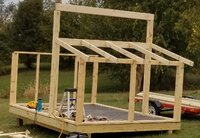- Thread starter
- #31
DoozyWombat
Songster
The entire floor does not need to be kept damp, you could simply dump their water out each day into a different place, then there will be a "wet" area and the rest will be mostly dry, then next day you dump it somewhere else and the previous place will be mostly dry again or just damp. You never want the wet to last more than a day or 2 anyway, that's when the anaerobic bacteria start up and you don't want those at all.
More good feedback. Thanks!



